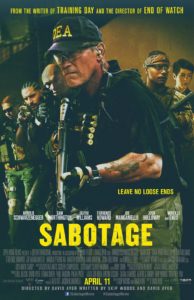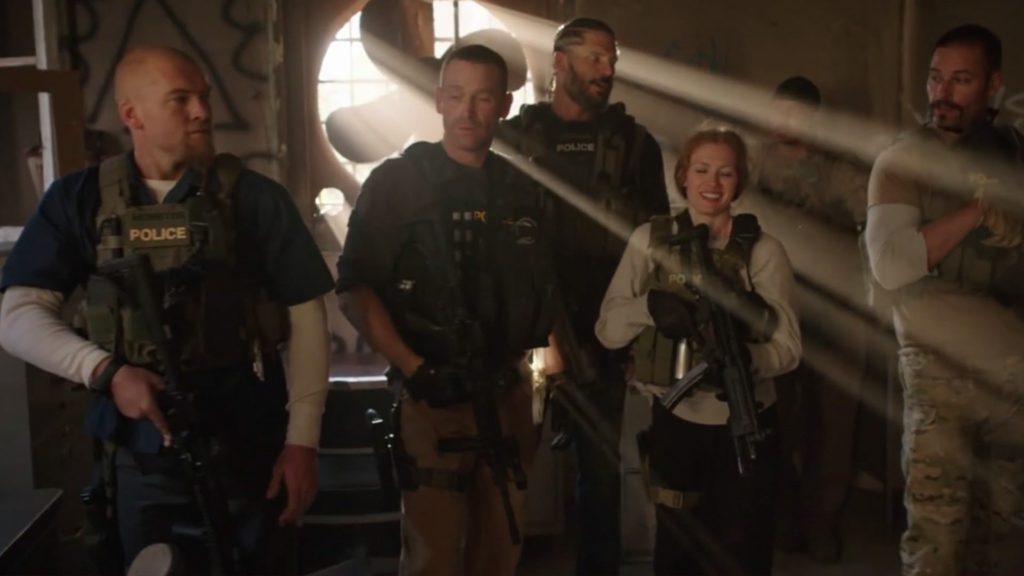Has This Film’s Screenplay Been… Sabotaged??
DIRECTOR: DAVID AYER/2014
 Sabotage seems confused to me, for a couple of different reasons. First of all, I’m not sure it knows exactly who its intended audience is, or even what kind of movie it’s supposed to be. It’s a down and dirty film that pulls no punches—a vulgar, dismal, hyper-violent, mean-spirited, grim-n-gritty, amoral and ugly little southern-fried crime flick. Right off the bat, that screams grindhouse movie.
Sabotage seems confused to me, for a couple of different reasons. First of all, I’m not sure it knows exactly who its intended audience is, or even what kind of movie it’s supposed to be. It’s a down and dirty film that pulls no punches—a vulgar, dismal, hyper-violent, mean-spirited, grim-n-gritty, amoral and ugly little southern-fried crime flick. Right off the bat, that screams grindhouse movie.
But Sabotage, directed by David Ayer (writer of the Oscar-winning Training Day and director of 2012’s well-received End of Watch), is too slickly well-made to come off as authentic exploitation. What’s more, there isn’t an ounce of fun to be had here—this is a movie without any semblance of humour; it takes itself far too seriously to play in any self-respecting grindhouse[1].
But if Ayer’s goal is to aim higher, then he’s aimed too high—Sabotage simply isn’t good enough to make up for its constant hammering of the audience with its relentless bleakness. If Ayer wants to have one foot in the grindhouse and one in the arthouse, then he’s failed as a filmmaker. Blending exploitation and art-film sensibilities requires an extraordinarily delicate sense of balance—even Tobe Hooper was only able to do it once with The Texas Chainsaw Massacre (admittedly, the best example of the grind-art-house film). The only filmmaker I can think of who was able to do this kind of thing on a consistent basis was Abel Ferrera (The Driller Killer, Ms. 45, Bad Lieutenant). To steal a famous quote and twist it to my own ends: David Ayer, I’m a fan of Abel Ferrera. I know his work. And you, sir, are no Abel Ferrera.
Not silly or fun enough to be exploitation, yet not meaningful enough to be anything else, “Sabotage” attempts to engage with a “Ten Little Indians”-style murder mystery as its central plot.
(The original title of the script was actually Ten, making one wonder if it was initially conceived as an adaptation/remake of the classic Agatha Christie story). But this is where the movie further shows its poor hand—when the answer to the whodunit is revealed, it doesn’t make a lick of sense, and completely falls apart under the barest amount of scrutiny. What’s even more puzzling is that there’s a clear answer to the murder mystery that would actually make sense within the film’s context—and make for a much more coherent and thoughtful film, I might add—so when the solution comes out of left field, it feels as if the script were re-written on the day of shooting to appease someone’s ego (perhaps the legendarily substantive ego of the Austrian Oak himself)? And so, the only real reason for paying attention—the driving force of the film—is completely gutted and falls apart in the last reel.

So who done it? Here’s a hint–the answer is nonsensical.
At least the movie itself movies along at a more-or-less smooth clip, although it’s a good fifteen minutes too long. Despite the bloat, it’s never really boring, even in spite of its desolate tone, and there are even a few really engaging action sequences (an early shootout and final act car chase are two in particular that stick out). The ensemble cast feels natural together at first, although their motivations and relationships to each other tend to wildly fluctuate depending on the needs of the half-baked script. Sometimes this kind of thing can happen when a big star like Schwarzenegger is cast—a delicately balanced story can be thrown into chaos by the script demands of a big actor—just look at what happened to Terminator: Salvation when Christian Bale came on board. I don’t know if that’s what happened in this case, but it’s clear that this script probably wasn’t originally written with Schwarzenegger in mind—anyone of appropriate age and/or gravitas could play his character, the leader of a corrupt undercover DEA task force. Nothing about his character, John “Breacher” Wharton, says Arnold Schwarzenegger, unlike, say, Ray Owens in last year’s The Last Stand, a much breezier movie that knew how to utilize its cast.
One of the biggest issues with Sabotage is simply that the characters aren’t likeable. For the most part, the members of the task force are slimy, bickering degenerates, who seem to be always attempting to one-up each other in terms of vulgar bravado, like a fourteen-year-old’s idea of what it means to be a “badass.” The only sympathetic member is played as a whining and emasculated cuckold, and the only other characters in the film with any type of moral upstanding are little more than cardboard cutouts.
When neither the characters nor the story nor the aesthetic come together, what then is left? A hollow, rotted-out shell of a movie starring hollow, rotted-out shells of characters. If it weren’t shot so well, it’d be an endurance test. As it is, it’s a movie I have no desire to ever revisit.
[1] I mean, this is a movie called Sabotage that never once utilizes the Beastie Boys’ song of the same name. Talk about a missed opportunity—that right there probably tells you everything you need to know about this film. That being said, save $7 and 90 minutes and watch this much superior film instead:

